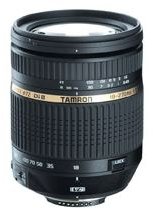Tamron Lens Review - The Tamron AF18-270mm F/3.5-6.3 Di II VC LD Aspherical (IF) Macro
Tamron AF18-270mm Lens
Hailed by Tamron as “The Ultimate All-In-One Zoom: Longest, Steadiest Lens On Earth”, the Tamron AF 18-270mm f/3.5-6.3 lens is the latest in the series of ‘Superzoom’ SLR lenses launched by manufacturers of late, the others being Canon EF-S 18-200mm F3.5-5.6 IS, Nikon 18-200mm f/3.5-5.6G IF-ED AF-S VR DX and the Sigma 18-200mm f/3.5-6.3 DC OS HSM. But does this lens really live up to the hype? Let’s find out in this lens review.

Specifications
(Taken from Tamron Website)
Focal Length 18-270mm ; Maximum Aperture F/3.5-6.3 ; Minimum Aperture F/22 ; Angle Of View 75°33’ - 5°55’ (equivalent angles of view when converted to 35mm) ; MFD (Minimum Focus Distance) 0.49m (19.3”) (entire zoom range) ; Diaphragm Blades 7 ; Filter Size Ø72mm ; Overall Length 101.0mm/3.8” ; Maximum Diameter 79.6mm ; Weight 19.4 oz. (550g) Max. Mag. Ratio 1:3.5 (at f=270mm, MFD 0.49m) ; Standard Accessory Flower-Shaped lens hood ; Compatible Mount Canon AF, Nikon AF-D
Features
1. 18 elements in 13 groups, including three aspherical elements and two Low Dispersion (LD) glass elements for the control of aberrations.
2. Offers a 35mm equivalent focal length range of 27-405mm (with 1.5X DX) or 29-432mm (1.6X APS-C) with F3.5 (at 18mm) to 6.3 (at 270 mm) maximum aperture.
3. Up to 4 stops Vibration Compensation (VC).
4. Available for Canon EF mount and Nikon F mount (APS-C/DX format DSLRs only).
5. The filter thread is 72mm, and thankfully, does not rotate while focusing. So you need not alter the polarizing filter each time you focus.
6. Lens hood ships as part of the package.
7. Currently, the lens is available in mounts for Nikon F and Canon EF.
Construction (4 out of 5)
The barrel is made of plastic with the mounts being metallic. The construction feels sturdy and is quite lightweight. This will be particularly appreciated by trekkers and mountain hikers who avoid taking a long zoom lens to the hills just because of its heavy weight.
The lens barrel features knobs for autofocus and vibration compensation (optical image stabilization). There’s also a lock knob for locking focus which also prevents zoom creep.
The large zoom ring occupies most of the barrel, and is perfectly placed with a ribbed rubberized surface. The zooming action has good tactile feel to it, and one can feel a distinct resistance after the 70mm mark.
The focus ring is right in front and naturally within the reach of the fingers, and offers a smooth action, though I also felt it’s a bit too smooth for precise manual focusing. I’d personally have liked it to have a bit more resistance, like the zoom ring.
One issue with the zoom lock button is that it locks zoom only at the minimum, i.e., 18mm point. So, if you’re taking a long exposure photo on a tripod with the lens pointing up or down, at anything other extreme wide-angle, or extreme telephoto, the lens tends to collapse or extend under its own weight. And the zoom lock is pretty much useless in this scenario. This may not be a concern for all, but can definitely cause irritation to some photographers.
Apart from this minor flaw, overall the lens is perfect in terms of design and construction with all controls being very accessibly placed.
Performance
Chromatic Aberration (3 out of 5)
For a lens with such a high zoom range, chromatic aberration was comparatively negligible. Images were optically quite clean throughout the zoom range from 18mm to around 200mm. Thereafter, at the highest telephoto settings, some purple fringing does occur in high contrast situations.
Sharpness (5 out of 5)
Images were very sharp throughout the zoom range, with truly exceptional results in the mid range of zoom. At both the extremities, there is some image softness, but nothing too noticeable.
Vignetting (5 out of 5)
Vignetting was not a problem throughout the zoom range from 18-270mm. This is quite commendable for such a long zoom range.
Lens Flare (5 out of 5)
Except when shooting directly into the sun, lens flare was not a problem at all. Shots taken at high zoom, backlit with strong sunlight produced negligible lens flare.
Autofocus (3 out of 5)
I felt the autofocus to be slightly sluggish. But for most situations it was quite accurate and gave sharp images.
Vibration Compensation (5 out of 5)
The optical image stabilization, known as VC by Tamron, works fairly good. The motor is super-silent, and provides good stabilization for up to at least 3 stops, if not 4. I took handheld images at even ¼ of a second shutter speed and they were quite acceptable in nature. Though at higher end of the telephoto range, the most stable handheld shot I could take was 1/20 of a second. But that’s quite decent, in my opinion, and if you use the burst mode along with it, you might just get very sharp shots even at low shutter speeds!
Value for money (4 out of 5)
The lens retails for around $600. That may seem steep, but considering that this lens offers a tremendous zoom range, and is extremely light weight, the price seems quite justified. It has no direct competition with a similar zoom range, and near rivals from Canon and Nikon, offering a lesser zoom range, are also similarly priced. This is one lens which is worth the money spent on it.
Conclusions
As with all lenses, there are pros and there are cons.
Pros:
1. A fantastic zoom range from 18mm to 270mm
2. Very compact and light weight
3. Excellent image quality
4. No significant lens flare or vignetting
5. Good optical image stabilization
Cons:
1. Zoom lock only functional at 18mm, causing zoom creep in certain situations
2. Purple fringing at high telephoto and high contrast situations
3. Slightly sluggish autofocus
But for an overall conclusion, it’s definitely ‘Recommended’.
Sample Images


